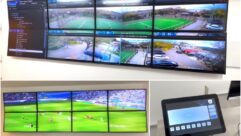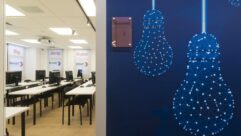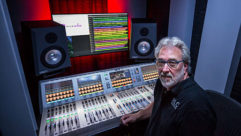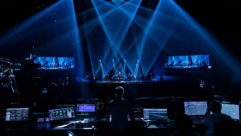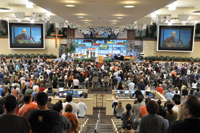

Recording Ministries
Dec 29, 2009 12:00 PM,
By Trevor Boyer
Three approaches to audio capture and distribution.
The Brooklyn Tabernacle Choir, directed by Carol Cymbala, has won six Grammy Awards for Best Gospel Choir or Chorus Album, most recently for Live … This is Your House in 2004. For the last three albums, including last year’s I’ll Say Yes, the Brooklyn Tabernacle has hired Nashville-based producers Tony High and Melissa Mattey to travel to Brooklyn and record tracks via Digidesign Pro Tools. For these recordings, the choir performs live on the sanctuary stage, just as it does every Sunday. FOH Engineer Doug Bull runs the Yamaha PM1D at front of house to give the band and the 300 choir members a monitor mix. This signal is split so that it can also be sent to the Pro Tools system on the fourth-floor recording studio.
These albums, of course, are fairly rare occurrences: The Brooklyn Tabernacle’s Technical Director Michael Archibald says the choir makes records about every other year. On a weekly basis, however, the church is still making use of Pro Tools for the somewhat mundane but equally important task of archiving and quickly generating copies of Pastor Jim Cymbala’s sermon and the choir’s music. The church is also interested in launching a weekly (traditional) radio show that comprises the audio of the church services. Grammies aside, the Brooklyn Tabernacle is a typical large church when it comes to recording its music and its message.
At churches, especially larger houses of worship, music and message often work hand in hand to instruct a congregation and focus its devotion. What these two modes of worship have in common, of course, is that audio represents their primary content. It’s no surprise, then, that many larger churches—many of which also have sophisticated sound-reinforcement—are set up to execute professional-level recording of the pastor’s sermons and praise music—whether recorded live or in a studio setting. Here we look at three examples.

Besides the weekly services, Saddleback Church’s
Mike Mierau is also responsible for recording the occasional conference, and there’s a podcast to produce weekly for iTunes and for drivetimedevotions.com.
Saddleback Church
Saddleback Church, with its main campus in Lake Forest, Calif., is perhaps best known as the home of Pastor Rick Warren, author of The Purpose Driven Life, and a speaker at the inauguration of President Obama in 2008. The church is spread across seven sites on the Lake Forest campus (both permanent buildings and Sprung air-conditioned tents) and four additional campuses in and near Orange County, and it hosts about 20,000 worshippers every week. Warren preaches from the Worship Center—the main auditorium in Lake Forest—and his message goes out via fiber to the other sites on campus. These sites, which have specific musical signatures such as hard rock and traditional praise music, capture the video and audio feeds of the sermon and delay them for 1 to 10 minutes.
Mike Mierau is in charge of making sure all those feeds are going out and that they’re being recorded. “I have 18 master outs to different locations,” he says. “So I’m feeding quite a few places at the same time.” Only one service per Sunday is recorded as a multitrack mix for posterity; the rest are recorded as stereo. For mixing, he uses a Digidesign D-Command control surface that’s attached to 96 channels of Digidesign preamps. Mierau is running Pro Tools 7.4.2. “I haven’t moved up to 8.0 yet because I’m all about stability,” he says. “Not to say that 8.0 is not stable, but I usually wait six months or so to move up because it’s too important for this room to be stable to move up to something that’s still kind of new.”

At Saddleback, the audio of its sermons are mixed at front of house on the Worship Center’s Digidesign Venue Profile console.
With his Pro Tools setup, Mierau uses Waves Audio’s FSL4000 as a primary plug-in. The console emulator is based on the ’80s/’90s pop-radio standby of the same name. “I’m an old recording/analog guy, so when I entered into doing the broadcast feeds for Saddleback, I implemented that because I like the sound of what Waves did,” he says. That plug-in is applied to most of his inputs except for those of the pastors’ Sennheiser SK 5212 transmitter with an MKE 2 lavalier microphones. For those inputs he uses a McDSP plug-in, the standard Digidesign compressor/limiter, and another plug-in from Massey. In his recording room, Mierau uses a pair of M-Audio Studiophile DSM3s as reference monitors.
Meanwhile, on Sunday at the offsite campuses, the audiences hear one of Warren’s two sermons that were delivered the previous day at Lake Forest. The audio for these sermons was mixed at front of house on the Worship Center’s Digidesign Venue Profile console. Depending on whether there’s an orchestra on stage, between 40 and 78 channels of audio are sent from FOH to Mierau at the recording studio. (He’s capable of receiving up to 96.) The audio and video feeds of those sermons are streamed from Mierau’s recording studio to a video-editing bay on campus, where songs are edited out. The sermon is then saved to a portable hard drive for each offsite campus and burned to DVDs, which serve as backups. In April, Saddleback also started an Internet Cafe, an almost-live stream to the Internet, and Fox News airs the church’s Easter and Christmas services every year.
As mentioned, most of these audio feeds exist as stereo mixes, but the 11:15 a.m. service on Sunday, recorded via wireless Sennheiser 5000 and 2000 series (praise singers are on 2000 HHs with the 965 heads; soloists use 5000 series HHs with Neumann 104 heads), is multitracked. “I log certain songs that I felt held up to a certain level,” Mierau says. “At some point in time, we’ll go back and review and decide on what we’re going to use for a worship CD.”
Besides the weekly services, Mierau is also responsible for recording the occasional conference, and there’s a podcast to produce weekly for iTunes and for drivetimedevotions.com, a new website dedicated to the podcast. Pastor Tom Holladay explicates five Bible chapters a week (using an AKG C 414 B-XLS mic), and Mierau records a week’s worth in one day and later edits and adds bumpers and music beds from Saddleback’s library. He records the podcast in one of the two video editing bays in Lake Forest—a “pseudo-studio,” as Eric Kibbe, the church’s audio director, calls it.
For all the Pro Tools work that the church executes, it’s helpful that the church serves as a beta site for Digidesign. (On the microphone side, Saddleback is also a beta site for Sennheiser.) For that reason—and because of the technical acumen that Saddleback collectively has on staff—the church usually does not hire systems integrators when it specifies and purchases new packages of recording, sound reinforcement, or broadcast gear. The exceptions are new buildings, such as the Refinery, which is the youth facility built on the Lake Forest campus last year. “On that size and scale of a project, where we have two different rooms that have three-cam HD video capture, we have actually sourced out to do some of the spec’ing on that,” Kibbe says. “But all our smaller projects, we pretty much do inhouse. We just updated all three of our tents, and we did it all inhouse.”
Acoustic Dimensions’ Craig Janssen designed the audiovisual infrastructure for the Worship Center and the Refinery. The install of both rooms was done by CCI solutions in Washington by Mark Pearson. Saddleback has hired SIA Acoustics of New York to tune the rooms.
Recording Ministries
Dec 29, 2009 12:00 PM,
By Trevor Boyer
Three approaches to audio capture and distribution.

At Mars Hill’s nine campuses, a Yamaha M7CL board outputs audio via an installed ADAT Lightpipe card, which has either 16 or 32 outputs, depending on the location. These channels feed a Mac Pro computer that’s running either
Pro Tools M-Powered or Apple Logic.
Mars Hill Church
Mars Hill Church has nine locations in the greater Seattle area and one in Albuquerque, N.M, but the church is nowhere near finished expanding. The church plans to open 90 more campuses in the next 10 years. “We’ve got a vision to dream big,” says Matthew Josey, the systems and operations manager for the church. That new title reflects a new approach to audiovisual systems for Mars Hill. Before, Josey was simply the church’s audio engineer. Now the idea is to standardize the systems as much as possible across campuses in order to avoid repeating the work of selecting a new system every time—a project that Josey is overseeing.
Considering the number of new campuses that Mars Hill is determined to open over the next decade, with audio and video systems largely duplicated from those of established campuses, it makes sense that the church has (just as Saddleback has) brought systems integration inhouse. Not only does the church save some money on new systems, but the on-staff integrator can also help maintain systems from week to week. “It is very beneficial to have an audio/video/lighting guy on staff who intimately knows their systems,” Josey says. “I feel like there’s a lot of [other] churches who fall into that thought pattern as well.”

Josey certainly knows the systems at Mars Hill, but at this point, the standardization has just started. So it’s a bit difficult for him to list all the various recording configurations. Still, some general rules apply. First is that live music is a key part of the worship experience at all Mars Hill campuses. Each location has at least a couple house bands, so recording is at minimum a weekly activity at each campus. “I can probably with confidence tell you that we’ve got 25 bands at the moment,” Josey says. “It’s probably higher.”
Each band’s Sunday performance is captured with Shure SM58 and Sennheiser e 935/945 mics, recorded to Marantz PMD660, PMD560, or Tascam DR-100 solid-state recorders as a stereo mix from front of house. (Mars Hill has decided to make the DR-100 the standard recording device going forward.) This is known as the band reference podcast, and it’s a private feed for band members. “That is so that bands, after they play, they can go back and say, ‘Well, this worked in this song; this worked in this service,’” Josey says. “It’s a tool for the bands to use to try to get better.”
The second general rule is that there’s a semi-standard setup for multitrack recording at the various campuses. The goal here is to polish worthy live performances—via multitrack mixing and occasionally some studio overdubbing—to the point that they can be posted to the Web. At most campuses, a Yamaha M7CL board outputs audio via an installed ADAT Lightpipe card, which has either 16 or 32 outputs, depending on the location. These channels feed a Mac Pro computer that’s running either Pro Tools M-Powered or Apple Logic. M-Powered is a version of Pro Tools that limits the number of tracks to 16. So if a campus is running up to 32 tracks, it runs Logic. None of these systems have a control surface attached; mixing is strictly via mouse.

After a volunteer mixes these tracks down to a stereo MP3, the next step is quality control. Brian Eichelberger, a part-time employee of Mars Hill and the only staff recording engineer on the audio side, receives this file via email and types up a short critique of the track. “He’s got a good ear; he knows what to look for within music,” Josey says. Eichelberger sends this critique to the volunteer recording engineer, and that person then either remixes and resubmits the song or simply takes the critique as a lesson for next time. If the mix passes muster, the track is uploaded to Mars Hill’s ever-growing public music library at www.marshillchurch.org/media/music.
With all the volunteer recording happening at Mars Hill’s 10 campuses, training is another process that the church is trying to standardize. Josey says that at the moment training is an ad-hoc process, but the plan is to offer free training via a series of web pages and blog posts in January, with videos to follow later. “Part of our goal in this is to do it for free, because we also want to make our training available to other churches who might stumble across it,” he says.
Meanwhile, there’s a separate track to the media ministry at Mars Hill. The church has a theologically rigorous and sometimes provocative pastor in Mark Driscoll, who preaches every Sunday at the church’s main campus in Ballard. His message is recorded every week for audio and video podcasts, and also for video playback at the nine other campuses the following week. A Pro Tools LE system records Driscoll’s headset (a DPA 4000 series mic), his wireless lav, wired lav, the audio from the video, a FOH board feed, and timecode. “Out of these, we choose the best input, usually the headset mic, and master it as needed,” Josey says. The audio file is then sent into Apple Final Cut Pro to be cut together with the camera feeds. (Most mics for bands and singers are a mix of Shure, including SM58s, and Sennheiser models, including 935s and 945s.) A staff audio-for-video engineer, Sam Stewart, handles postproduction for these tasks, as well as all music beds for the many preproduced videos that Mars Hill creates. “He’s a guy who has his own projects, his own deadlines that are separate from the music side of things,” Josey says. “They’re two very different workflows.”
Stewart works in his own studio at the Ballard location, where about 45 percent of the congregation worships. The house PA there comprises Meyer Sound CQ-1 loudspeakers with 700-HP subwoofers. Like many of the volunteers, Stewart runs Apple Logic for multitrack editing. The studio has a MOTU HD-192 interface and a Sound Devices hard-disk recorder, with Aphex 1788 preamps, and Summit Audio compressors and dbx Professional Products 160 compressor/limiters. There’s also Digidesign 192 I/O gear in the studio, but the church is waiting for budget to come through to get Stewart a core card so he can run a full Pro Tools rig.
Recording Ministries
Dec 29, 2009 12:00 PM,
By Trevor Boyer
Three approaches to audio capture and distribution.

At Brooklyn Tabernacle, FOH Engineer
Doug Bull runs the Yamaha PM1D at front of house to give the band and the 300 choir members a monitor mix. This signal is split so that it can also be sent to the Pro Tools system on the fourth-floor recording studio.
Brooklyn Tabernacle
The Brooklyn Tabernacle also is currently missing some parts of the full Pro Tools rig that it uses to record tracks for its Grammy-winning choral albums. That’s by design, though. When producers Tony High and Melissa Mattey visit to record, the church rents preamps that the pair specifies for each instrument. “They’ll generally use stuff that they’ve known,” says Bull, the FOH engineer. “Classic preamps—things like APIs on the drums.” (The Brooklyn Tabernacle does own two sets of Vintech Audio 473 preamps for vocal recording.) The 300-voice choir is recorded live from its usual spot on the Tabernacle stage with Schoeps Microphones. From the fourth floor, in what’s technically a separate building from the old Vaudeville theater that is the Tabernacle, the two producers watch the action on stage via a video monitor and use a simple Yamaha 01V96 console for listenback. Across from the Pro Tools tracking studio is a vocal booth, which is used for overdub. After recording, High and Mattey take the tracks back to Nashville on hard drives to mix in a typical professional studio with a Solid State Logic board. (Archibald, the chuch’s technical director, says that the last album’s songs were each composed of 200 or more tracks.)
Though he’s not the recording engineer, Bull is integral to the recording process. As the front-of-house engineer, he’s responsible for letting the choir and the band know how they sound as they’re being recorded. A few years ago, Archibald bought a small FM transmitter from Radio Shack. Bull routes the FOH mix through this, in effect running a little pirate-radio station in the church when the Brooklyn Tabernacle Choir is recording. Choir members tune in and listen to the monitor mix on cheap Walkman-type devices, with one earphone engaged as they sing. On Sundays, the choir uses traditional wedge monitors onstage, but the bleed from these make a pristine recording impossible. (Soloists use new wireless mics with Shure UR transmitters and either Beta 87 or SM58 capsules.)

From the fourth-floor recording studio at Brooklyn Tabernacle, two church producers can watch the church stage via a video monitor and use a Yamaha 01V96 console for listenback.
In addition to mixing for the monitors, Bull helps the production team understand the audio infrastructure of the church. “I know how to get stuff routed, so I’ll get stuff routed for them,” he says. “That way their concern is really getting great tracks.”
As mentioned, the audio channel routing within the Brooklyn is fairly complicated. The switch from an analog Soundcraft Series Five board to the digital PM1D opened up the number of channels that could be sent around the building from 48 input/output channels to 128 analog and 128 digital channels on the input side, and 128 analog and 64 digital outputs. The three-way splitter sends 48 of those AES/EBU digital output signals to a Tascam X-48 solid-state recorder. This captures the discrete audio channels of the sermons and praise music every week, and this feeds four Recordex CD duplicators as well as a Pro Tools workstation with a small Digi 003 rack at FOH.
Related Links

You may have noticed lately that the world-class level of sound you’ve become used to at major league rock concerts has begun migrating into the local clubs, where it’s increasingly common to see small line-array PAs flown alongside the stage with projection video and LCD screens. …

Keeping the Economic Faith: Houses of Worship Roundtable
Amid a two-year-long recession, it’s difficult to analyze anything except through the prism of economics. So we asked several leading systems integrators who specialize in the house of worship market…

Wireless In-ear Monitoring Systems
In-ear monitoring (IEM) is at the apex of a series of tech advances that have led up to the ability of stage performers having their own customized monitoring environment in a live music situation….
For visitors who want a copy of that day’s services, Bull quickly adds an audio header to the captured file and the Recordex duplicators go to work. For the iTunes podcast of the weekly services, Bull also cleans undesirable elements such as coughs from the track.
As churches go, the Tabernacle is a pretty loud house, sometimes reaching 107dB, according to Archibald. That SPL is thanks to its EAW loudspeakers (MQ and TD series) that are arranged in a left-center-right configuration, Bag End subwoofers, and Crown Audio amplifiers. The recording from the Tascam X-48 allows Bull to do a virtual soundcheck over the house PA the next week. “You can play those same 48 tracks back to the console and do tweaks to the system, which I’ve found really helped the sound quality because things change over time,” Bull says. “The drummer will get a new head. I can track that on Sunday and be mixing it, but then later come back and say, ‘Well, how was that kick? How was that snare sound?’ You can go back and play that exact mix through the house again [with] exactly the settings you did on Sunday.”
As with Saddleback’s Refinery, Acoustic Dimensions integrated the initial sound reinforcement infrastructure at the Brooklyn Tabernacle in late 2001. For an upgrade to Yamaha’s DME hardware for DSP, the church consulted Harold Rubens, who had done FOH mixing for the choir when it was on tour. Archibald has also specified and integrated gear himself. According to Archibald and Bull, the Brooklyn Tabernacle is not shy about spending money when the audiovisual system will benefit, but it also needs to know that the audiovisual department will actually employ its technological investments. “That’s one of the reasons we had not invested in a digital console prior to Doug [Bull being hired in 2007],” Archibald says. “We had no one efficient enough to run one. I’ve found a lot of churches I’ve traveled to have all this top gear and they’re terrified to change anything.”


